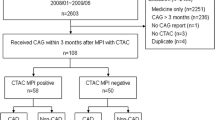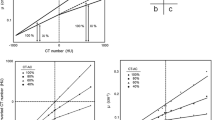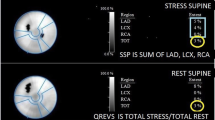Abstract
Background
Transient ischemic dilation (TID) has been established as an important independent marker of severe and extensive coronary artery disease (CAD) in myocardial perfusion imaging (MPI). The accuracy of the TID index is dependent on a well-determined threshold (normal limits) between normal and abnormal values for each study protocol. To date, the effects of neither gender nor attenuation correction (AC) on TID normal limits have been established. Thus, the objectives of this study were to determine if AC processing changes the normal value of the TID index and if there were gender-related differences in the TID index of normal patients who had undergone rest/exercise-stress technetium-99m sestamibi MPI.
Methods and Results
Seventy-five patients (33 women, 42 men; mean age, 57.7 ± 11.7 y and 55.9 ± 10.0 y, respectively) with less than a 5% likelihood of CAD, who had undergone low-dose rest/high-dose exercise-stress Tc-99m sestamibi MPI, were studied. All studies were acquired using simultaneous emission/transmission scans and were corrected for attenuation, scatter, and resolution effects using the ExSPECT II method. Both the AC and non-AC studies were analyzed using the Emory Cardiac Toolbox (ECTb; Syntermed, Inc, Atlanta, Ga) quantitative software. The TID index was calculated automatically as the ratio of stress mean left ventricular volumes to rest mean left ventricular volumes by ECTb. Patients were grouped by gender and the TID indices from AC and non-AC studies were compared. Linear regressions of the TID index and body mass index were analyzed to exclude differences in body size between male and female patients as a confounding factor in gender-related differences in TID. The TID index upper normal limits were calculated as the mean value plus 2 standard deviations (SDs). AC processing did not change the TID index significantly whether the genders were combined or separated (AC TID = 0.97 ± 0.14 vs non-AC TID = 0.98 ± 0.12 for all patients). Female patients showed higher mean TID indices than male patients in both AC (1.01 ± 0.15 vs 0.95 ± 0.12) and non-AC studies (1.00 ± 0.15 vs. 0.97 ± 0.10), but this difference was statistically significant only in AC studies (p = .03). TID indices remained constant across the range of body mass index studied. The TID index upper normal limit was 1.31 for female and 1.18 for male patients.
Conclusion
TID normal values for rest/exercise-stress Tc-99m sestamibi MPI are gender-dependent and not affected by AC processing. Thus, diagnosticians should take into account these gender-related differences, as compared with the traditional value generated from mostly
Similar content being viewed by others
References
Ritchie JL, Bateman TM, Bonow RO, Crawford MH, Gibbons RJ, Hall RJ, et al. Guidelines for clinical use of cardiac radionuclide imaging: a report of the American College of Cardiology/American Heart Association Task Force on assessment of diagnostic and therapeutic cardiovascular procedures (Committee on Radionuclide Imaging)—developed in collaboration with the American Society of Nuclear Cardiology. J Nucl Cardiol 1995;2:72–92.
Van Train KF, Garcia EV, Maddahi J, Areeda J, Cooke CD, Kiat H, et al. Multicenter trial validation for quantitative analysis of same-day rest-stress technetium-99m-sestamibi myocardial tomograms. J Nucl Med 1994;35:609–18.
Nichols K, Santana CA, Folks R, Krawczynska E, Cooke CD, Faber TL, et al. Comparison between ECTb and QGS for assessment of left ventricular function from gated myocardial perfusion SPECT. J Nucl Cardiol 2002;9:285–93.
Grossman GB, Garcia EV, Bateman TM, Heller GV, Johnson LL, Folks RD, et al. Quantitative Tc-99m sestamibi attenuation-corrected SPECT: development and multicenter trial validation of myocardial perfusion stress gender-independent normal database in an obese population. J Nucl Cardiol 2004;3:263–372.
Williams KA, Schuster RA, Williams KA Jr, Schneider CM, Pokhama HK. Correct spatial normalization of myocardial perfusion SPECT improves detection of multivessel coronary artery disease. J Nucl Cardiol 2003; 10:353–60.
McLaughlin MG, Danias PG. Transient ischemic dilation: a powerful diagnostic and prognostic finding of stress myocardial perfusion imaging. J Nucl Cardiol 2002;9:663–7.
Weiss AT, Berman DS, Lew AS, Nielsen J, Potkin B, Swan HJ, et al. Transient ischemic dilation of the left ventricle on stress thallium-201 scintigraphy: a marker of severe and extensive coronary artery disease. J Am Coll Cardiol 1987;9:752–9.
Mazzanti M, Germano G, Kiat H, Kavanagh PB, Alexanderson E, Friedman JD, et al. Identification of severe and extensive coronary artery disease by automatic measurement of transient ischemic dilation of the left ventricle in dual-isotope myocardial perfusion SPECT. J Am Coll Cardiol 1996;27:1612–20.
Abidov A, Bax JJ, Hayes SW, Cohen I, Nishina H, Yoda S, et al. Integration of automatically measured transient ischemic dilation ratio into interpretation of adenosine stress myocardial perfusion SPECT for detection of severe and extensive CAD. J Nucl Med 2004;45:1999–2007.
Takeishi Y, Tono-oka I, Ikeda K, Komatani A, Tsuiki K, Yasui S. Dilation of the left ventricular cavity on dypiridamole thallium-201 imaging: a new marker of triple-vessel disease. Am Heart J 1991;121:466–75.
Daou D, Delahaye N, Vilain D, Lebtahi R, Faraggi M, Le Guludec D. Identification of extensive coronary artery disease: incremental value of exercise T1-201 SPECT to clinical and stress test variables. J Nucl Cardiol 2002;9:161–8.
Hansen CL, Sangrigoli R, Nkadi E, Kramer M. Comparison of pulmonary uptake with transient cavity dilation after exercise thallium-201 perfusion imaging. J Am Coll Cardiol 1999;33: 1323–7.
Diamond GA, Forrester JS. Analysis of probability as an aid in the clinical diagnosis of coronary artery disease. N Engl J Med 1979; 300:1350–8.
Galt JR, Blais M, Cullom SJ, Vansant JP, Garcia EV. Quality control of transmission scans for attenuation collection in cardiac SPECT [abstract]. J Nucl Med 1999;40:286P.
Case JA, Cullom SJ, Bateman TM. Noise reduction in transmission computed tomography for cardiac SPECT attenuation collection using a gamma prior [abstract]. J Nucl Med 1998;39:181P.
Vantage Pro™ user’s manual 2000. Milpitas, CA: ADAC Laboratories.
Case JA, Bateman TM, Cullom SJ, Arram S, Galt J, Garcia EV. Impact of transmission scan reconstruction using an iterative algorithm (BITGA) versus FBP: clinical appearance of attenuation-corrected myocardial perfusion SPECT images [abstract]. J Nucl Med 2001;42:51P.
Case JA, Pan TS, O’Brian-Penney B, King MA, Luo DS, Rabin MSZ. Reduction of truncation artifacts in fan beam transmission imaging using a spatially varying gamma prior. IEEE-TNS 1995; 42:1310–20.
Mobasseri S, Hendel R. Cardiac Imaging in women: use of radionuclide myocardial perfusion imaging and echocardiography for acute chest pain. Cardiol Rev 2002; 10:149–60.
Author information
Authors and Affiliations
Corresponding author
Additional information
This work was funded in part by the National Institutes of Health; National Heart, Lung, and Blood Institute, grant number K01 HL70422. Some of the authors receive royalties from the sale of the Emory Cardiac Toolbox (E.V.G., R.D.F.) and/or ExSPECT II (E.V.G., R.D.F., T.M.B.) related to the research described in this article. The terms of this arrangement have been reviewed and approved by Emory University in accordance with its conflict-of-interest practice.
Rights and permissions
About this article
Cite this article
Rivero, A., Santana, C., Folks, R.D. et al. Attenuation correction reveals gender-related differences in the normal values of transient ischemic dilation index in rest-exercise stress sestamibi myocardial perfusion imaging. J Nucl Cardiol 13, 338–344 (2006). https://doi.org/10.1016/j.nuclcard.2006.03.003
Received:
Accepted:
Issue Date:
DOI: https://doi.org/10.1016/j.nuclcard.2006.03.003




